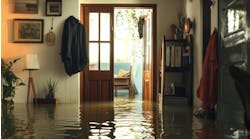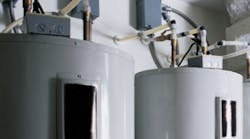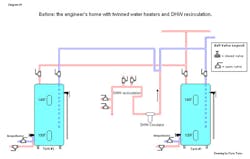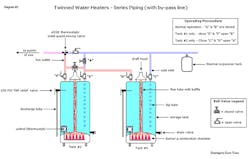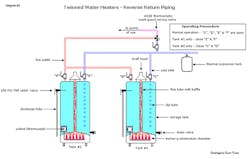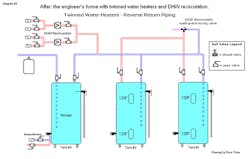Latest from Management
Show Customers All the Ways They Can Buy
Sponsored
Twinning water heaters can be relatively easy to accomplish if you pay attention to how the water lines are piped.
Diagram No. 1 shows how two electric water heaters were piped.
In order to utilize the waste heat from the two ground source heat pump (GSHP) desuperheaters, the upper elements were turned up to 140°F while the lower elements were turned down to 100°F. A four-zone DHW (domestic hot water) recirculation system was installed with no insulation on the supply or return lines and no check valve had been utilized. The wet rotor circulator was not orientated correctly. The owner is an electrical engineer and had tracked every watt of energy utilized: he was not a happy camper.
Here are the issues:
- Water in the second water heater tank was cloudy and had a rank smell — no doubt full of bacteria. Think like water: would you flow through that second tank?
- No thermostatic scald guard valve. When you, as a professional contractor, turn up the thermostat (on any water heater) above its factory setting, you are setting up a scenario where thermal scald burn dangers loom large. Got liability insurance? If you think you have enough — think again!
- No insulation on the DHW outgoing lines and none on the four return lines. With a single DHW circulator running 24/7, the owner had been able to accurately record the wasted watts by recording with the system on and off. All water lines, with the exception of those in the relatively small mechanical room, could not be accessed to add insulation.
- No check valve equals reverse flow in the recirculation return lines, which equals luke-warm water in the bathing modules.
Now that the National Appliance Energy Conservation Act (NAECA) April 16, 2015, deadline has passed, the urge to avoid compliance has homeowners, and mechanical contractors, looking for ways to bypass the new energy rules.
Sammy Hagar’s I can’t Drive 55 must have been playing in the memories of the folks at the DOE when they chose 55 gallons as the limit for bumping tank-style energy factor (EF) efficiencies to .75 for gas ((V = volume) 0.8012 - (0.00078 x V); and an EF above 1.9 (EF = 2.057 - (0.00113 x V) for electric.
Over 55 gallons? For those who don’t want to have a heat pump water heater in their home, and have enough room for a second tank, twinning two electric tanks will be popular. Likewise, customers who don’t want to utilize a tankless water heater will favor twinning two gas tank water heaters.
After ensuring there is enough power for that second 30-amp 220-volt circuit, or that the existing chimney can handle another exhaust and the gas line is properly sized to accommodate the added load, you turn your attention to the cold and hot water piping for your twinned tank application.
Two basic piping choices
There are two basic piping choices: series or reverse return.
For series piping see diagram No. 2.
Series piping will cause the first-in-line water heater to do the lion’s share of water heating. The added resistance to flow can become a nuisance in older homes with higher-flow bathing faucets. This piping method will be required if the twinned tanks are different volumes. If either tank needs to be turned off for service or replacement, there will be no access to DHW for the occupants.
For reverse return piping see diagram No. 3.
The best method for piping twinned water heaters of equal size is the reverse return method as illustrated. With valving installed as shown, no interruption of service is necessary unless both tanks fail simultaneously — a highly unlikely event.
Thinking like water once again, we can easily see why reverse return piping balances the flow. On one side, the supply water wants to take the shortest route and dive into that first tank. On the outlet, by giving the second tank the shortest exit route, the flow literally can’t help but become balanced.
How were the issues resolved for the engineer homeowner? See diagram No. 4 and the below bullet points.
- The twinned electric water heaters were re-piped using reverse-return to ensure balanced flow.
- A third storage-only (electric water heater not connected to power) tank was added, so that both GSHP desuperheaters’ efficiencies were improved by “seeing” a cold tank to offload Btus.
- All active electric tank thermostats were reset to their original factory settings.
- A check valve was installed in each of the four DHW recirculation return lines and the four zones were re-piped to two zones with each having its own wireless DHW circulator. At the remote points-of-use, the wireless transmitter (manual per the homeowners’ request) can be utilized to turn on the zone and when hot water completes its run to the temperature sensor at the circulator, it turns off recirculation. In spite of not being able to insulate the lines, the prior wattage waste has been eliminated.
NAECA is going to cause all of us some problems due to the increased diameter and height of tank-style water heaters. For those homes where the existing water heater was shoehorned into an all-too-tight space, our homeowners are going to be faced with expensive solutions. Just remember: we’re just the messengers, so give them the DOE contact info!
All Dave Yates material in print and on Contractor's Website is protected by Copyright 2015. Any reuse of this material (print or electronic) must first have the expressed written permission of Dave Yates and Contractor magazine. Please contact via e-mail at: [email protected].
Dave Yates
Dave Yates material in print and on Contractor’s Website is protected by Copyright 2017. Any reuse of this material (print or electronic) must first have the expressed written permission of Dave Yates and Contractor magazine.

